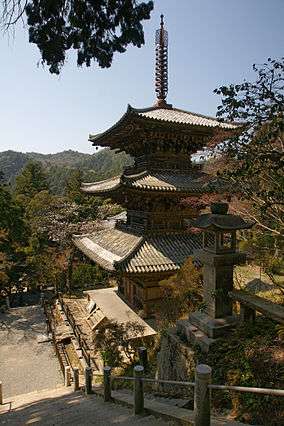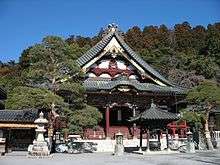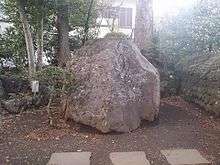Nikkō Shōnin
| Nikkō Shōnin (日興上人) | |
|---|---|
 Nikkō Shōnin in his grey robes | |
| Religion | Nichiren Shōshū Buddhism |
| School | Hokke Buddhism |
| Education |
Shijuku-in Temple in Fujikawa, Iwabuchi, Shizuoka Jissoji Temple in Iwamoto, Fuji, Shizuoka Prefecture |
| Personal | |
| Nationality | Japanese |
| Born |
8 March 1246 Kajikazawa, Kai Province, Japan |
| Died |
7 February 1333 (aged 86) Suruga Province, Japan |
| Parents |
|
| Senior posting | |
| Based in | Japan |
| Title |
Byakuren Ajari Nikko Shonin Other names: Hokibo Hokiko Hawakibo Byakuren Ajari |
| Predecessor | Nichiren |
| Successor | Nichimoku Shōnin |
| Rank | Second High Priest of Nichiren Shōshū |
| Part of a series on |
| Buddhism in Japan |
|---|
 |
Nikko Shonin (Classical Chinese: 日興 Buddhist name: Hawaki-bō Byakuren Ajari Nikkō 伯耆房白蓮阿闍梨日興, 8 March 1246 — 7 February 1333) was a senior disciple of Nichiren and was the former chief priest of Kuon-ji temple in Mount Minobu, Japan. As one of the six senior disciples of Nichiren, he then became the founder of Nichiren Shōshū Buddhism in the Mount Fuji vicinity. Nikkō is prominently known for enshrining the venerated Dai-Gohonzon mandala as well as transcribing the Ogazawari Gohonzon inside the Dai Kyakuden Hall where the Ushitora Gongyo is performed daily by the Nichiren Shōshū High Priest.
According to the doctrines of the Nichiren Shōshū school, Nikkō singularly upheld the doctrine that Nichiren was the True and Eternal Buddha in the Latter Age of the Law (Mappō) and therefore is the sole legitimate successor to the ministry and legacy of Nichiren. His official crest used today is the tortoise shell, a popular symbol of longevity. Nikkō is also known for his notable handiwork of keeping meticulous temple records during his lifetime, along with a sternful keeping of a highly organized religious practice, much of recorded research that survives today in both Nichiren-shū and Nichiren Shōshū repositories.[1]
The grave of Nikkō Shōnin remains today in Kitayama Honmonji, Omosu, in Suruga Province where he lived for thirty-six years, establishing a Buddhist seminary in the Nichiren-shū religion. The Koshi-E memorial feast of his death anniversary is commemorated on February 7.[2]
Early life
Nikkō was born at Kajikazawa in Koma District of Kai Province.[3] His father, Oi-no Kitsuroku was from Totumi province and later moved to Kai province while maintaining his samurai career. Nikkō's mother was Myofuku Tsunashima (née Yui) and was from what is now Shizuoka Prefecture. He died when Nikkō was a child. He was raised by his grandfather, Nyudo Yui. As a child, he entered the Tendai temple Shijuku-in, in Fujiwakabacho, Iwabuchi. He took the acolyte name, "Hokibo" and received his education here, which as well as Tendai doctrine, included Chinese classics, Japanese literature, poetry, calligraphy, as well as other subjects.[3]
Conversion to Nichiren's teachings
In 1257, Nichiren visited Jisso-ji Temple closely affiliated with Shijuku-in Temple where he studied various Buddhist sutras in its library for his treatise Risshō Ankoku Ron (立正安国論, "Establishing the Correct teaching for the Peace of the Land"). Nikkō served Nichiren here, and vowed to become his disciple. In addition, Nikkō also accompanied Nichiren on his two exiles. Nikkō is also credited with preserving many of Nichiren's voluminous writings. He was particularly careful to ensure the survival of Nichiren's many letters written in simple characters (Kana) for uneducated followers.
One of Nichiren's six senior disciples
On 8 October 1282, Nikkō became one of the six senior priests whom Nichiren designated to carry on his faith after his death. According to Nichiren Shōshū doctrine, on October 13 Nichiren further designated Nikkō the chief priest of Kuon-ji, the temple at Mt. Minobu in Yamanashi Prefecture, where Nichiren had spent the last years of his life as purportedly recorded in a transfer document called Minobu-zan Fuzoku-sho ("Document entrusting Mt. Minobu"); however, the authenticity of this document is disputed by other branches of Nichiren. Later that same day, Nichiren died at Ikegami, now part of Tokyo.
Following Nichiren's 100th day funeral ceremonies, Nikkō left Ikegami on October 21 to carry Nichiren's ashes back to Mount Minobu, arriving on October 25. On the centenarian anniversary of Nichiren's death, Nikkō, the other five senior priests, and their disciples conducted a 100th-day memorial service, after which the others departed for their own territories where they were most active. Nikkō carried out his duties as chief priest of Kuon-ji, teaching disciples and looking after the laity. Central to his work was attending, cleaning and maintaining Nichiren's tomb, and collecting and cataloguing Nichiren's many writings for preservation and perpetuation.
Isolation from other disciples

Latter feelings of animosity and discord grew after the second death anniversary of Nichiren's 100th Day Memorial ceremony (23 January 1283) when the rotation system as agreed upon the "Shuso Gosenge Kiroku" (English: Record document of founder's demise) and Rembo Cho (English: Rotation Wheel System) to clean and maintain Nichiren's grave, according to Nikko was seldomly being abandoned by the other five senior disciples.
By the third death anniversary of Nichiren (13 October 1284), Nikkō claimed that the other five senior priests no longer returned to Nichiren's tomb in Mount Minobu, citing the deer hoofs and other signs of neglect at the gravesite. In addition, Nikkō made accusatory charges that after Nichiren's death, the other disciples slowly began to gradually deviate from what Nikkō viewed as Nichiren's orthodox teachings.
Chief among these complaints is the syncretism by some of the disciples to worship images of both Shakyamuni Buddha while admonishing other disciple priests for signing their names "Tendai Shamon" of the Tendai Buddhist school in the subsequent documents notarized and sent to the Kamakura government. Furthermore, Nikko Shonin alleges that the other disciples became condescending towards some of Nichiren's writings because not written in Classical Chinese, as they were written in a Katakana syllabary dialect which was deemed inferior at the time.
Accordingly, Nikkō's own converted shakubuku, the steward of the temple district, Hagiri Sanenaga, also began to commit unorthodox practice deemed to be heretical such as the following:
- The crafting of a standing statue of Shakyamuni Buddha as an object of worship.
- The donation of noren shrine curtains and horses to the Mishima Taisha Shinto shrine, at the time an honorary shrine of the Hōjō-clan shogunate.
- The procurement of bamboo lumber for the Shinto Gassan Shrine.
- The attendance of a memorial service dedicated to the stupa of Amida Buddha along with giving monetary donations to its Nembutsu priests in Fukushi ward, Nanbu, Yamanashi Prefecture.
These controversial acts received tolerance from another senior disciple, Mimbu Nikō (民部日向, 1253–1314) to be acceptable due to having been done ordinarily with the knowledge of Nichiren while he was alive. Accordingly, Hagiri Sanenaga provided his own personal reason that it was customary for his political family to make homage to the Shinto shrine of the Kamakura Shogunate, as well as reasoning that he had provided monetary donations to other Buddhist sects even when Nichiren himself was alive.
Such developments eventually led Nikkō to conclude that Nichiren's enlightened entity no longer reside and continue at Mount Minobu. Furthermore, he felt that Kuon-ji was not the place for perpetuating Nichiren's teachings causing him to pack up his belongings, and allegedly some relics belonging to Nichiren to depart, never to return. Nikkō left Mount Minobu with a group of select disciples in the spring of 1289. Nanjo Shichijo-jiro Tokimitsu was a lay believer residing near Mount Fuji offered them sanctuary to stay, later donating a tract of land for a new temple that became Taiseki-ji Temple. Taiseki-ji is today the head temple of the Nichiren Shōshū school and, since its founding on 12 October 1290, has always been a major center of the Kōmon-ha (興門派, also called the 富士派: Fuji-ha) branch of Nichiren Buddhism, as the schools stemming from Nikkō were traditionally known.
Upon nearing death, Nikkō named his disciple Nichimoku (1260–1333) as his successor and passed onto him the Ozagawari Gohonzon now enshrined inside the Dai-Kyakuden, along with his Juzu beads made of Crystal and Shimamenu Onyx which are now preserved in the Gohozo building of Taisekiji.
For the remaining 36 years of his life, Nikkō then retired a few miles away to Omosu, Suruga Province where he founded a seminary and temple, Ikegami Honmon-ji belonging to Nichiren-shū sect, and concentrated on training disciples until his death in the second lunar month of 1333 at the age of 87. A grave claiming to house the ash remains of Nikkō Shōnin is located in Kitayama Honmonji Temple in Suruga Province. After his death within this same temple, a statue of the solar goddess Amaterasu Omi-Kami and the protector god Hachiman was enshrined, donated by some early Hokkekō believers. Such sculptural images are considered only decorative in present teachings of the Nichiren Shōshū school.
Buddhist articles claimed to have been brought to Taisekiji Head Temple
According to the doctrinal beliefs of Nichiren Shōshū, Nikkō Shonin left Mount Minobu with several articles pertaining to Nichiren, namely the following:
- The Dai Gohonzon Mandala
- Transfer inheritance documents of his legitimacy as chief priest of Kuon-ji and as successor
- Several Gohonzon mandalas inscribed by Nichiren
- Partial bones and ashes of Nichiren
- The Onikuge, a piece of tooth belonging to Nichiren
- A dragon candlestick, koro incense burner and vase Nichiren used when summoning rain during times of drought for the peasant devotees.
- The Namamiei statue (Mieido) and the Sacred Treasure (Hoando) statue of Nichiren Daishōnin
Claim to Nichiren's successorship
Some followers of the Nichiren schools stemming from Nikkō, in particular Nichiren Shōshū, view Nikkō as the sole legitimate successor to Nichiren and therefore the high priest of the school. This is based on a document dated the ninth lunar month of 1282 called the Nichiren ichigo guhō fuzoku-sho ("Document assigning all the teachings spread by Nichiren during his lifetime"). In this document, Nichiren entrusts the "entirety of his lifetime of teaching" to Nikkō and names him the "supreme leader of propagation of the true teaching".
Other Nichiren lineages of the other original five senior disciples vehemently reject this claim of successorship, as the surviving document does not exist in Nichiren's hand or any of his immediate disciples, rather copied down by Nikko's extant disciples. Instead, such schools claim that Nikko Shonin was only a resident priest in Kuonji Temple before 1285, rather became the Chief Priest of that temple from 1285–1289, just before he left to move to the Taisekiji area.
Some of Nikkō's direct disciples also eventually spawned schools that deviated to some degree or another from the doctrines maintained by Taiseki-ji, often due to political pressure or internal power plays going back and forth to separating or rejoining Taisekiji before and after World War II.
Original Japanese terms
References
- ↑ http://www.nichiren-shu.org/newsletter/nichirenshu_news/Nichiren153e.pdf
- ↑ Ryuei Michael McCormick. "Nichiren (1222–1282)". San Jose Sangha. Archived from the original on 2016-01-01.
- 1 2 The Soka Gakkai Dictionary of Buddhism: "Nikkō"
Sources
- Nikkō Shōnin Nichimoku Shōnin Shōden (日興上人・日目上人正伝: "Orthodox biography of Nikkō Shōnin and Nichimoku Shōnin"), Taisekiji, 1982
- Nichiren Daishōnin Shōden (日蓮大聖人正伝: "Orthodox biography of Nichiren Daishōnin"), Taisekiji, 1981
- The Life of Nichiren Daishonin. Kirimura, Yasuji. Nichiren Shoshu International Center (a former department of the Soka Gakkai), 1980
